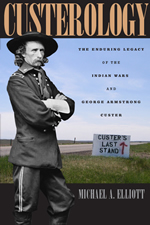Larry McMurtry on Custerology

In the most famous defeat in American military history Lieutenant Colonel George A. Custer lost his life along with most of the rest of his 7th Cavalry at the now famous Battle of Little Bighorn, also known as Custer’s Last Stand.
In the ensuing years the defeat has become a powerful symbol of America’s bloody past, with everyone from tourists and historians to Native American activists attempting to interpret and explain the battle in the context of the multicultural present. In the March 6 New York Review of Books, Larry McMurtry reviews Michael A. Elliott’s new book Custerology: The Enduring Legacy of the Indian Wars and George Armstrong Custer and explores the complicated question of why the battle retains such power for Americans today. McMurtry writes:
Even as the sun set for Custer, dawn broke for the Custerologists—as Michael Elliott calls them—whose numbers now darken the sky. If you don’t believe me, write yourself some life insurance, then head up to Hardin, Montana, toward the end of June, and you’ll be able to take in not one but two reenactments of the Battle of the Little Bighorn, one sponsored by the town of Hardin itself (admission $16) and one put on by the powerful Crow family called the Real Birds (admission $12).
The Crow were scouts for Custer, and fought along with him. I attended the Crow sundance once, which might as well have been held in Harvard Yard, so thick were the white ethnologists on the ground. It would probably have been warmer in Harvard Yard too.
No one should think that because 130 years have passed since the battle the passions between tribes and within tribes have abated. Much of Michael Elliott’s book is devoted to explaining that people who might have been expected to calm down in that length of time in fact haven’t calmed down at all.
Read the rest of the review on the New York review of Books website.
Also read an excerpt from the book.